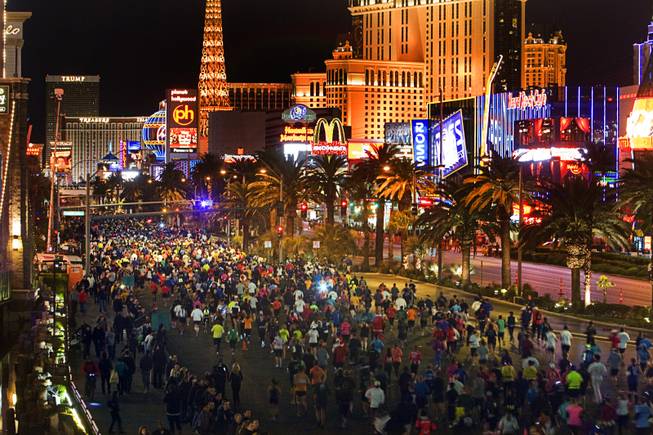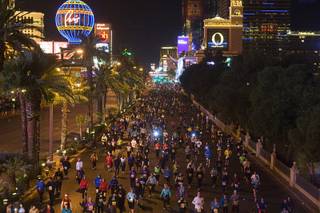
Runners head northbound on the Las Vegas Strip during the Zappos.com Rock ‘n’ Roll Las Vegas Marathon on Sunday, Dec. 4, 2011. The marathon and half-marathon attracted 44,000 official entrants from all 50 states and 54 countries, organizers said.
Thursday, Dec. 8, 2011 | 4:12 p.m.
Related content
Runners who became ill after the Rock ‘n’ Roll Marathon and half marathon Sunday night continued to register their complaints on Facebook today, but at least one of the sickened runners is happy: She got her money back.
The woman’s daughter, identified on the social media website as Britt Lee S, said her mother received the refund after a telephone conversation with race organizers. She emailed the Sun what appears to be a receipt for a refund of the $130 entry fee.
A spokesman for the Competitor Group couldn’t confirm this afternoon whether refunds had been issued in response to complaints about the staging of the race.
For Britt Lee S the refund settled the issue. “It’s hard to be mad at someone who was reasonable,” she said via e-mail.
But for the dozens of other participants, it’s far from resolved.
Many posted complaints of intestinal problems after the race, pointing fingers at the use of water from fire hydrants at water stations.
Race organizers filled lined buckets or trash cans with hydrant water, which was used to fill cups offered to racers along the course.
At least one racer from Las Vegas, who asked not to be identified, said that when she finished her drink, she tossed her emptied paper cup into garbage cans, not knowing if the containers were for water or garbage.
“A garbage can is a garbage can, how can you tell one from the other? Nobody tells you it might be a water source,” she said. “The water was awful tasting. But when you’re desperate you take anything.”
Race organizers said the hydrant water was tested and found to be safe before they attached meters and hoses to fill the lined garbage cans.
Jennifer Sizemore, a spokeswoman for the Southern Nevada Health District, said the agency is posting a survey for participants to fill out to see if they can pinpoint the cause of the reported illnesses. People could have gotten sick from a common source that has nothing to do with the water, she added. So far, Sizemore said, her office has received about 10 complaints.
The complaints are a concern to Clark County commissioners, who approved permits and closed the Strip for the race. But they said they are waiting for a fuller picture of the issues to emerge before responding to a call from some runners to find a new race organizer.
Commissioner Steve Sisolak, who fired the starting gun for the race, said his office has received a few phone calls about problems.
“I think what we’re hearing is that we’re going to have to do a little bit more planning, work through some of these things before the next race,” he said.
He also wondered: “If there are 200 complaints on the Internet does that mean the other 43,000 had a great time? I don’t know.”
Commissioner Tom Collins, who chairs the Las Vegas Convention and Visitors Authority, the agency responsible for drumming up interest in Las Vegas as a tourist destination, said it’s “hard to draw conclusions” so soon after the race.
“They’ve organized these races for several years,” Collins said of Competitor Group Inc., which stages the Rock ‘n’ Roll-brand marathons. “Why (problems) this year versus the previous years? It could be anything. Maybe there’s something else these runners did or took or prepared with or whatever. Who knows if it was a bad batch of something else? Maybe it was the garbage can liners. I hate to even try to speculate.”
The event drew some 44,000 racers who paid between $130 and $179 to run a half or full marathon, a portion of it on the Las Vegas Strip.
Last year, the race drew about 20,000 participants.
Aside from concerns about the water, the biggest complaint among those commenting online was overcrowding on the course that resulted in racers colliding, people falling and crushes of people at the end and start of the race.
Pat Christenson, president of Las Vegas Events, a private, non-profit funded by a hotel room tax and set up to bring events to Las Vegas, said his agency is working closely with Competitor Group to address the issues that came up.
“In every event we produce, we want to work with the best of the best and if you go through all the marathons Competitor Group have produced, this is very uncommon,” Christenson said. “But the fact is, maybe they tried to grow it a little too quickly … whether they should have had two start lines, spread it out more--those are all things we will examine.”
From the standpoint of hotels on the Strip, he added, “the impact was really good. I’m hearing from hotel properties they had very, very good numbers. But the biggest question is: How do you do this safely and comfortably at that size or bigger? Or can you do that? Those are things we’ll be looking at.”


Join the Discussion:
Check this out for a full explanation of our conversion to the LiveFyre commenting system and instructions on how to sign up for an account.
Full comments policy